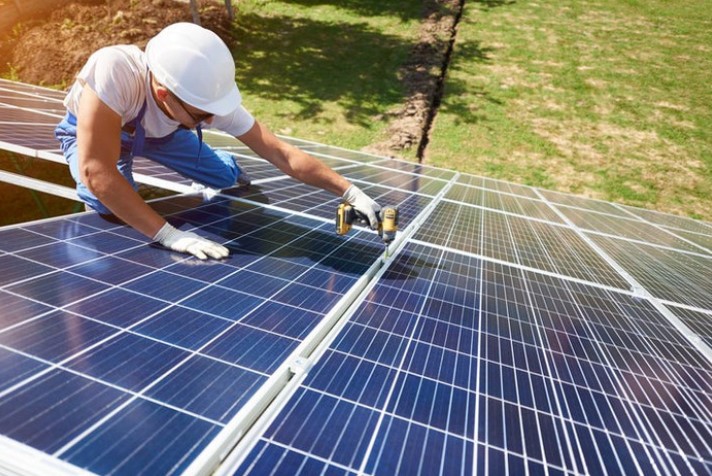
Solar energy is growing quickly. Very quickly.
Consider that the United States had less than 200 megawatts of installed solar power capacity at the end of 2009, but has added at least that much in seven of the first nine months of 2019. The nation ended September with 32,000 megawatts of installed solar power capacity from utility-scale infrastructure, and an additional 15,000 megawatts or so of small-scale (mostly rooftop) solar installations. Together, they’ll combine to generate about 3% of the country’s total electricity this year.
That’s impressive, but it’s barely scratching the surface of solar energy’s potential. The United States could soon be building 18,000 megawatts of utility-scale solar per year. That long-term growth potential makes Enphase Energy (NASDAQ:ENPH) and SolarEdge Technologies (NASDAQ:SEDG) solid growth stocks to buy in December, despite concerns over premium valuations or short-seller reports. Here’s why.
Solar’s growth is just heating up
NextEra Energy generates more electricity from the wind and sun than any other company on the planet. It owns more wind power capacity than all but seven countries. It’s also one of the largest capital investors in the United States, a label earned by being the country’s leading developer of new wind and solar power infrastructure.
In other words, the company has invaluable insight into the future of renewable energy in the United States. That’s why investors shouldn’t overlook its long-term projections, which are significantly more optimistic than any other estimate floating around. Among them: NextEra Energy thinks the United States could build enough new onshore wind and utility-scale solar to derive up to 40% of its total electricity from the renewable duo by 2030.
Solar energy is a driving force behind that projection. Specifically, NextEra Energy projects that solar energy will become the second-lowest-cost source of electricity production around 2023 — even when energy storage is included, and even as the investment tax credit (ITC) steps down in value. Reaching that inflection point will result in at least 18,000 megawatts of new utility-scale solar being built per year from 2023 to 2030, according to the company. And that excludes rooftop solar additions in the budding commercial and residential markets.
It’s possible that NextEra Energy is wrong, or is simply juicing the numbers because it has a vested interest in doing so, but cross-checking the company’s estimates against utility-level development plans suggests that the optimistic scenario may turn out to be the most realistic of the mid-term projections out there. That bodes well for Enphase Energy and SolarEdge Technologies.
The masters of microinverters
Enphase Energy and SolarEdge Technologies have built technology platforms around their industry-leading microinverters, which convert electricity created by solar panels from direct current to alternating current. Microinverters are a required component for any solar project, large or small, and must comply with strict codes in the U.S. electrical system (and similar regulations internationally).
That’s created an amazing growth opportunity for both companies to exploit with their simple, reliable, and value-creating products.
In the first nine months of 2019, Enphase Energy delivered revenue of $414 million, up 85% from the year-ago period. The business also generated operating income of $58 million in the same span this year, compared to an operating loss of $3 million in the first nine months of 2018. Management guided for the fourth quarter of 2019 to be the first-ever with $200 million in sales.
Meanwhile, SolarEdge Technologies expects to generate $1.4 billion in revenue and $207 million in operating income in 2019. That will mark impressive growth from the totals put up last year, at just $937 million and $139 million, respectively.
But investors have begun to fret that the growth will prove unsustainable. After all, Enphase Energy and SolarEdge Technologies own a combined 90% of the microinverter market in the United States. Throw in what are considered premium valuations — relative to expected full-year 2019 revenue, shares of Enphase Energy trade at 5 times sales and shares of SolarEdge Technologies sit below 3 times sales — and it seems like investors are always waiting for the solar stocks to tumble. However, worried investors appear to be missing the bigger picture.
Microinverters are important, but it’s more complicated now
The rapidly evolving requirements of solar hardware have forced Enphase Energy and SolarEdge Technologies to develop more sophisticated, more integrated offerings for customers. Both companies are developing hardware that incorporates inverters, energy storage products, and energy management systems and software.
For example, Enphase Energy will benefit from recent and upcoming product launches, such as its IQ 7A microinverters (compatible with higher-capacity solar panels, a key innovation in lowering the cost of solar energy) and a revamped offering of energy storage products. There’s also the future debut of next-generation IQ 8 microinverters, which boast 31% more computing power than the IQ 7 microinverters currently driving growth. The faster, smaller, and more powerful inverters will also lower costs for customers.
SolarEdge Technologies has even more ambitious plans that extend to electric vehicle charging and powertrain technologies, battery cell development, and diverse software products. While it expects 97% of its revenue to be generated from microinverters in 2019, the company expects that could dwindle to 75% by 2023 and 66% in the future.
In other words, the increasing complexity of the hardware that must accompany solar modules creates an opportunity for Enphase Energy and SolarEdge Technologies to build moats around their microinverter businesses and entrench themselves in new market segments. If they continue to execute, then their growth trajectories are only just beginning — similar to that for solar energy.
